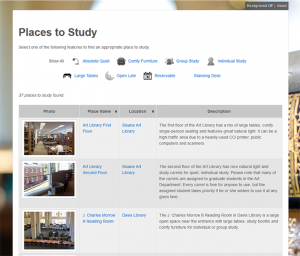Introduction
Imagine this scenario: You’re so frustrated with a product or service that you write an angry review immediately after the experience. However, you decide not to send it. Although corporations may not be pleased with this review, they can at least use the honest feedback to better their product. Let’s make the scenario even better. What if the company pays you to provide the honest feedback? We adopted this strategy to conduct a diary study.
Places to Study is an online tool that enables students to find the most suitable study space. Places to Study allows users to filter through search criteria, such as “comfortable furniture” or “standing desks.” We plan to redesign the Places to Study interface to increase usability. However, we wanted to start our process with identifying our users’ motivations, thoughts, and experiences for using Places to Study.

A Diary? Seriously?
Yes, we asked participants to maintain a diary for two weeks. We’re not the only ones. Diary studies are research studies that occur throughout a specified amount of time. Diary studies are often used in psychological and user experience research. Diary studies are recommended when you want to understand user behavior over an allotted amount of time.
What did we do?
Prior to the beginning of the study, we requested that participants attend a briefing session. In this session, we answered questions about the study and outlined expectations. Also, we gave each student a $10 Amazon gift card in these sessions.
Instead of using paper diaries, we opted for using electronic diaries. Therefore, we created ten Qualtrics surveys and asked participants to respond. Each day, we sent participants a link to the surveys. To maintain privacy, we assigned each participant a randomly generated number. Thus, the participants’ responses did not directly correlate to their identity. Also, we stored the participant responses separately from the other preliminary information. At the end of each week, participants received a $20 Amazon gift card. The total incentive amount was $50 in Amazon gift cards.
How did it go?
Research shows to overrecruit for participation because participants often underestimate the time requirements of the study. We sought to recruit fifteen participants. We confirmed thirteen for the study. There were a few minor technical difficulties with sending the prompts. Initially, we had the surveys expire at the end of the day to encourage participants to complete them in the specified time range. However, this did not accommodate our participants’ schedules. Thus, we eliminated the expiration date because we did not want to lose valuable data. Ultimately, we thought the study went well. Diary studies are unique because the moderators are minimally involved in the daily tasks of the study.
Conclusion
Overall, we learned a few insights about students’ motivations for using study spaces:
- The atmosphere (e.g. lighting, noise level) seemed to be the most important factor in searching for a space.
- Students thought that Places to Study would have been more beneficial if they learned about it earlier in their academic career.
- Mobile capabilities would cause students to use Places to Study more frequently.
- Enforce a word count. You want to ensure that the responses you receive contain as much data as possible.
We hope to conduct more diary studies in the future.
Resources
- Bolger, N., Davis, A., & Rafaeli, E. (2003). Diary Methods: Capturing Life as it is Lived . Annual Review of Psychology , 54, 579–616.
- Flaherty, K. (2016, June 5). Diary Studies: Understanding Long-Term User Behavior and Experiences. Retrieved December 17, 2018, from https://www.nngroup.com/articles/diary-studies/
- Lallemand, C. (2012). Dear Diary: Using Diaries to Study User Experience. User Experience Magazine, 11(3). Retrieved from http://uxpamagazine.org/dear-diary-using-diaries-to-study-user-experience/
- Malhotra, S. (2017, August 14). Tips for Conducting Effective Diary Studies . Retrieved December 2018, from https://medium.com/@sareekamalhotra/tips-for-conducting-effective-diary-studies-5fa536502383
- Moule, J. (2016, May 19). Use a Diary Study to Extend Your UX research. Retrieved from UX Mastery website: https://uxmastery.com/diary-study-extending-ux-research/
- (n.d.). Discovery Methods Chapter 5: Diary Study. Retrieved from https://www.userinterviews.com/ux-research-field-guide-chapter/diary-studies
- Ohly, S., Sonnentag, S., Niessen, C., & Zapf, D. (2010). Diary Studies in Organizational Research: An Introduction and Some Practical Recommendations. Journal of Personal Psychology, 9(2), 79–93.
- Priestner, A., & Borg, M. (2016). User Experience in Libraries: Applying Ethnography and Human Centered Design. London, England : Routledge.